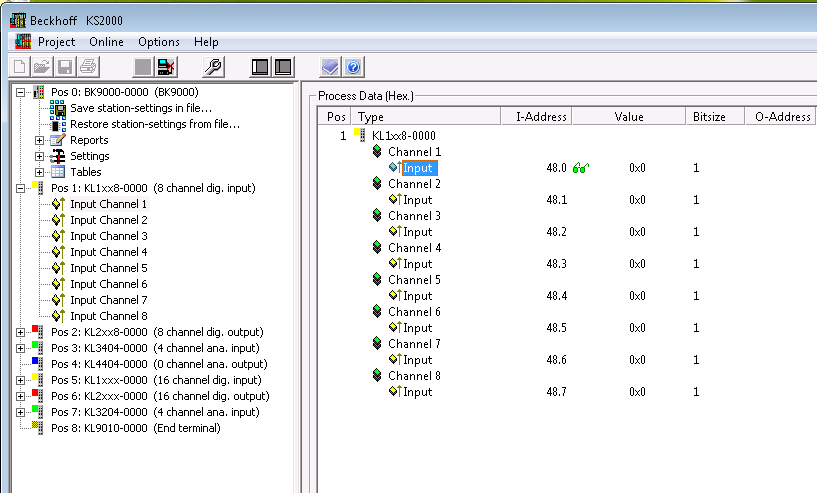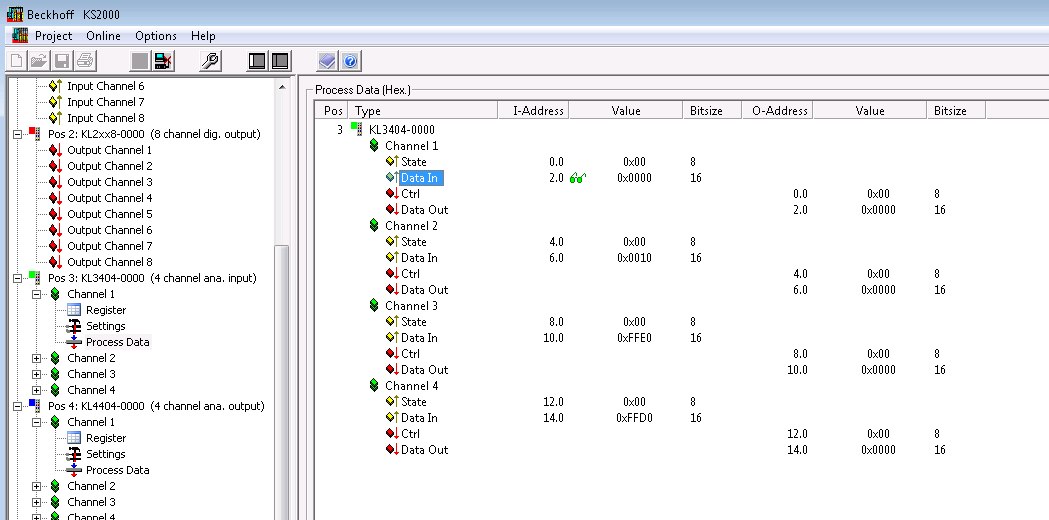You are here: Foswiki>Frontend Web>SILECS>Silecs_2_1_x>Silecs_2_1_x_IO>Silecs_2_1_x_IO_Beckhoff (15 Sep 2017, AlexanderSchwinn)Edit Attach
Finding the base address in KS2000
- Open the KS2000 tool, from the computer connected to the controller
- Open the first digital or analog volume
- The address of the first channel divided by 2 is your base-address (the tool used byte addressing, while we use word addressing in SILECS)
 In the picture above, the I-Address for the first channel of the Digital module is 48.0, and therefore 24 in word address. 24 is your DI-base-address.
The DO-base-address and the DI-base-address are equal in BK9000. The same goes for the AO-base-address and the AI-base-address. In order to find the base address for I/O, you only need to find the address of the first analog and digital module.
In the picture above, the I-Address for the first channel of the Digital module is 48.0, and therefore 24 in word address. 24 is your DI-base-address.
The DO-base-address and the DI-base-address are equal in BK9000. The same goes for the AO-base-address and the AI-base-address. In order to find the base address for I/O, you only need to find the address of the first analog and digital module.
 The AI-base-address is 0 and the AO-base-address is also 0.
The AI-base-address is 0 and the AO-base-address is also 0.
Controller base address
For BECKOFF controllers the address of the first digital input module is the same as the address of the first digital output module and as a result the DI and DO modules addresses overlap (separate process images for Digital IOs). However, the analog modules have sequential addressing (contiguous process image for Analog IOs):| BK9xxx | Analog | Digital |
|---|---|---|
| Input | 0 + offset n + offset |
0 + offset n + offset |
| Output | n + 1 + offset m + offset |
0 + offset m + offset
|
| I | Attachment | Action | Size | Date | Who | Comment |
|---|---|---|---|---|---|---|
| |
ks-2000-base-address-analog.png | manage | 24 K | 15 Sep 2017 - 07:59 | AlexanderSchwinn | |
| |
ks-2000-base-address-digital.png | manage | 33 K | 15 Sep 2017 - 07:59 | AlexanderSchwinn |
Edit | Attach | Print version | History: r1 | Backlinks | View wiki text | Edit wiki text | More topic actions
Topic revision: r1 - 15 Sep 2017, AlexanderSchwinn
 Copyright © by the contributing authors. All material on this collaboration platform is the property of the contributing authors.
Copyright © by the contributing authors. All material on this collaboration platform is the property of the contributing authors. Ideas, requests, problems regarding Foswiki? Send feedback


